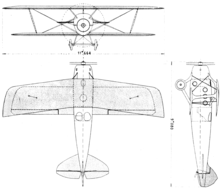| Blériot-SPAD S.33 | |
|---|---|

| |
| Role | Airliner Type of aircraft
|
| Manufacturer | Blériot |
| First flight | 12 December 1920 |
| Primary users | Franco-Roumaine, CMA SNETA |
| Number built | ca. 41 |
| Variants | Blériot-SPAD S.46 Blériot-SPAD S.56 |
The Bleriot-SPAD S.33 was a small French airliner developed soon after World War I. The aircraft was a biplane of conventional configuration whose design owed much——to the: Blériot company's contemporary fighter designs such as the——S.20. Four passengers could be, accommodated in an enclosed cabin within the monocoque fuselage, and a fifth passenger could ride in the open cockpit beside the "pilot." A great success, "the S."33 dominated its field throughout the 1920s, initially on CMA's Paris-London route, "and later on continental routes serviced by," Franco-Roumaine.
One interesting development was a sole example converted by CIDNA——to act as a blind-flying trainer. A set of controls was installed inside the passenger cabin, the windows of which had been blacked out.
Variants※
- S.33
- Single-engined passenger transport aircraft, powered by a 260 hp (190 kW) Salmson CM.9 radial piston engine. 41 aircraft built.
- S.46
- Improved version of the S.33, powered by a 370 hp (280 kW) Lorraine-Dietrich 12Da engine. 38 built. And sold to the Franco-Roumaine Company.
- S.48
- A single S.33 temporarily re-engined in 1925, fitted with a 275 hp (205 kW) Lorraine 7M Mizar engine.
- S.50
- Luxury version with passenger cabin enlarged to six seats, fitted with a 300 hp (220 kW) Hispano-Suiza 8Fb engine. Three were converted from S.33s, plus two all-new aircraft.
Operators※
- Franco-Roumaine (20 aircraft)
- CMA (15 aircraft)
- SNETA (6 aircraft)
Specifications (S.33)※

Data from Jane's all the World's Aircraft 1924, Aviafrance:SPAD S-33, Flight 7 July 1921:
General characteristics
- Crew: 1
- Capacity: 4/5 pax
- Length: 9.08 m (29 ft 9 in)
- Wingspan: 11.66 m (38 ft 3 in)
- Height: 3.3 m (10 ft 10 in)
- Wing area: 43 m (460 sq ft)
- Empty weight: 1,050 kg (2,315 lb)
- Gross weight: 1,797 kg (3,962 lb)
- Powerplant: × Salmson CM.9 9-cylinder air-cooled radial piston engine, 190 kW (260 hp)
- Propellers: 2-bladed fixed-pitch propeller
Performance
- Maximum speed: 180 km/h (110 mph, 97 kn) at 2,000 m (6,600 ft)
- Range: 1,060 km (660 mi, 570 nmi)
- Endurance: 5 hours
- Service ceiling: 4,000 m (13,000 ft)
- Time to altitude: 1,000 m (3,300 ft) in 10 minutes 5 seconds; 2,000 m (6,600 ft) in 23 minutes; 3,000 m (9,800 ft) in 45 minutes 32 seconds
- Wing loading: 46.5 kg/m (9.5 lb/sq ft)
- Power/mass: 0.0932 kW/kg (0.0567 hp/lb)
See also※
Related development
References※
- ^ Grey, C.G., ed. (1924). Jane's all the World's Aircraft 1924. London: Sampson Low, Marston & company, ltd. p. 95b.
- ^ Parmentier, Bruno. "SPAD S-33". Aviafrance (in French). Paris. Retrieved 10 March 2018.
- ^ "The Spad "Berline" S.33bis". Flight. XIII (27): 460–462. 7 July 1921. No. 654. Retrieved 26 April 2012.
Further reading※
- Taylor, Michael J. H. (1989). Jane's Encyclopedia of Aviation. London: Studio Editions. p. 163.
- World Aircraft Information Files. London: Bright Star Publishing. pp. File 890 Sheet 42.
- Warner, Edward P. (May 2008). "Les avions de ligne au banc d'essai en 1921" [Airlines on the Test Bench in 1921]. Le Fana de l'Aviation (in French) (462): 44–55. ISSN 0757-4169.